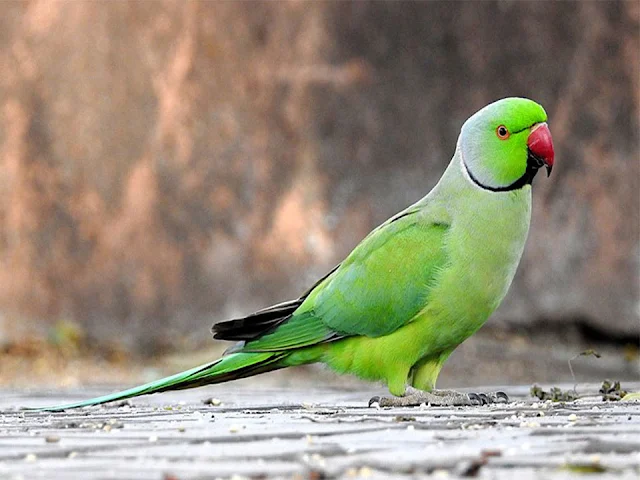Rose Ringed Parakeet, also known
as “Ring-Necked Parakeet” is a middle-sized parrot belongs to the “Psittacula”.
It has a wide range of varieties.
Size
Rose Ringed Parakeets is typically
16 inches (40 cm) long with tail feathers. The tail feathers are a large part of
their entire size. The normal length of single wing ranges between 5.9 to 6.9
inches (15 to 17.5 cm).
Appearance
Rose Ringed Parakeet is generally
pondered sexually dimorphic. The matured male parrot display a red & black
neck-ring, whereas, the female or younger bird either show no neck-ring or display
shadow comparable pale to dark-grey neck-rings. Both sexes have a distinctive green color. In wild, Rose Ringed Parakeet is a very noisy breed with a distinctive
shrieking call, and captive birds can be trained to speak.
Rose Ringed Parakeets are one
of exceptional parrots which can adjust well to live in disturbed environments.
They have tolerated much assault on the developments. As a common pet breed, escaped
birds have occupied a large number of cities around the world, including Northern
and Western Europe. The breed is documented as the smallest anxiety by “IUCN” (International
Union for Conservation of Nature) as its population appears to be increasing,
but its recognition as a pet bird and disregard with agriculturalists have dropped
its numbers in many areas of its native range.
Distribution
There are four subspecies recognized,
though they differ a small bit:
African Subspecies
African Rose Ringed Parakeet is generally seen in western
Africa in areas: Guinea, Senegal, and southern Mauritania, Uganda, and southern
Sudan, Egypt. African Rose Ringed Parakeets are also inhabitant at Nile valley
and surely in Giza. They occasionally are seen on the north coast and Sinai. The species
was bred first in Israel during 1980s and it is thought to be an antagonistic breed.
Abyssinian Rose Ringed
Parakeet is commonly
seen in Northwest Somalia, Ethiopia, and Sennar District of Sudan.
Asian Subspecies
Indian Rose Ringed Parakeet is innate to southern
Indian subcontinent. The breed has wild and adjusted populations around the world.
In Australia, London, USA, and some other western countries, the breed is often
represented as ‘Indian Ring Neck Parrot’.
Boreal Rose Ringed Parakeet is generally prevalent in
countries: Pakistan, Bangladesh, India, Nepal, and Burma. Though, adapted population
is found worldwide.
Indian
subspecies are bigger than African subspecies.
Diet and Feeding
In wild, Rose Ringed Parakeets
mostly feed on shoots, fruits, nuts, vegetables, and seeds. The wild flocks can
fly many miles to get food from woodlands and groves, and they also get wild injuries.
In India, the breed gets food from cereal grains, however, in winters they feed
on pigeon-peas. In Egypt, Rose Ringed Parakeets generally feed on mulberry during
the spring and in summers they feed on dates. Rose Ringed Parakeets make their
nests in palm-trees and get food from sunflower and corn-fields.
In captivity, they take excessive
food comprising vegetables, fruits, seeds, and even a small amount of roasted
meat to get the protein. Though, fats, salts, chocolate, liquor, and other flavors
should be avoided.
Breeding
Indian Rose Ringed Parakeets make
pairs from September to December timeframe in north-west India. They do not
have permanent mating partners and they often mate with an alternative partner
during the next breeding. During winter seasons, they like to live and guard their
nests, thus avoiding competition for residences with other birds. Feeding on
winter pea-crops delivers the females with nutrients essential for egg
production. From April to June, they look after their new babies. The young
birds start fledging before monsoon season and leave their nests.
Aviculture
They are widespread home pets
and they have a long history in aviculture. The first Greeks retained the Indian
subspecies ‘P. Krameri Manillensis’, and the early Romans saved the African
subspecies ‘P. Krameri Krameri’. The color variations in Indian breed have
become generally accessible in recent years.
Mimicry
Both male and female individuals
of Rose Ringed Parakeet breed have the skill to learn human dialogs. Initially,
the breed concentrates to its environments, and then they copy the voices of humans.
These parrots eager to learning are fairly bred at homes.
Rose-Ringed Parakeet
 |
| Pet Parrot having a blue-color mutation |
















1 Comments
Great article! Thanks for sharing I added some thoughts on parakeet food sometime ago
ReplyDelete